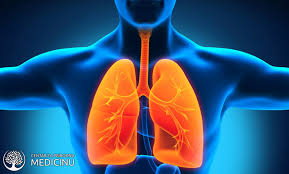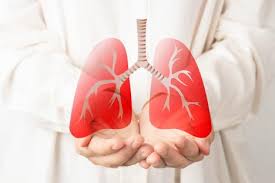
Pneumonia
PNEUMONIA
Pneumonia is an inflammatory condition localized in the lungs, particularly in the smallest and most remote parts of the lower respiratory system. Despite the availability of powerful antimicrobial drugs on the market today, these inflammatory diseases continue to be a significant issue in modern medicine. The mortality rate caused by this group of diseases remains fairly high. The disease typically begins with symptoms like weakness, fatigue, elevated or high body temperature, an initially dry and irritating cough, followed by a productive cough with mucus or purulent sputum. In rare cases, the sputum may contain blood clots or even pure blood, which signals to doctors that the pneumonia is a more severe form requiring careful diagnosis and treatment. Pneumonia can be caused by bacterial and non-bacterial agents. Due to its often uncharacteristic clinical course, non-bacterial pneumonia is commonly referred to as atypical pneumonia.
Lung Cancer (Carcinoma)
Lung tumors can be malignant (cancerous) or benign (non-cancerous). Lung cancer is a malignant tumor, which is not a contagious disease and cannot be transmitted from person to person. Malignant tumors consist of pathologically altered cells that have the ability to spread beyond their original site. If left untreated, the tumor can invade and destroy surrounding tissues. Sometimes, cells spread from the primary tumor site via blood or lymph vessels, reaching other tissues and organs and forming new tumors, known as metastases. The most common risk factors for developing lung cancer include smoking, environmental factors (such as air pollution), and genetic predisposition (family history). The primary and most common symptoms of lung cancer include persistent cough, coughing up blood, chest pain when coughing or breathing deeply, difficulty breathing, pneumonia that does not resolve after treatment, or recurrent pneumonia in the same area, along with loss of appetite and weight. These symptoms can also be caused by other diseases that are not cancerous, but if any of them occur, it is important to consult a doctor.


Pulmonary Thromboembolism (Pulmonary Infarction)
Pulmonary thromboembolism is a vascular disease that occurs as a complication of venous thrombosis (blood clot formation in veins) when a clot breaks loose and is carried through the circulation to the lungs. The clinical picture depends on the size and number of pulmonary arteries that are blocked, i.e., the severity of the pulmonary embolism. In cases of massive pulmonary embolism (when more than 50% of the circulation is blocked), characteristic symptoms such as difficulty breathing, chest pain (either sharp or pressure-like), irritating cough with hemoptysis (coughing up blood), palpitations, feelings of impending death, and signs of shock (drop in blood pressure, rapid, weak pulse, cyanosis—blue lips—and cold sweat) often occur. In non-massive pulmonary embolism cases, the clinical picture may be milder, with only a few of the symptoms present. The thrombus typically originates from the thrombosed deep veins of the lower legs, upper legs, pelvis, inferior vena cava, or right heart, and less frequently from the veins in the upper extremities.
Chronic Obstructive Pulmonary Disease (COPD)
Chronic obstructive pulmonary disease (COPD) is characterized by the restriction (narrowing) of airflow in the airways. This limitation of airflow is progressive and is associated with the inflammatory response of the lungs to harmful particles or gases. COPD patients experience smaller airways, thicker and swollen airway walls, and increased mucus production, which is then coughed up. The condition is most commonly seen in smokers or former smokers, individuals living in environments with high levels of air pollutants (such as those using coal or wood for heating), or those who have worked in environments with excessive dust or smoke. COPD primarily affects individuals over 40, though younger people can also develop the disease. Common symptoms include coughing with the production of mucus, difficulty breathing, shortness of breath, and a longer recovery time from colds. As the disease progresses, symptoms worsen, and many patients mistakenly attribute their coughing to smoking.
Asthma and Allergy
Asthma is defined as a chronic inflammation of the airways, causing them to become overly sensitive to various external triggers. This leads to narrowing of the airways, resulting in breathing difficulties, coughing, wheezing, and a feeling of tightness in the chest. These symptoms are most common at night or in the early morning but can also occur during the day. The prevalence of asthma has steadily increased in recent decades, especially among children, teenagers, and in highly developed countries. Allergic asthma is a disease of modern society, often referred to as an epidemic of the 21st century. Approximately 350 million people worldwide suffer from asthma, and an additional 150 million are expected to develop the disease in the next decade. Two-thirds of asthma cases are believed to be allergic asthma, with allergens such as house dust, mites, mold, animal dander, and pollen from trees, grasses, and weeds being common triggers.
Sarcoidosis
Sarcoidosis is a systemic disease of unknown origin, characterized by the appearance of sarcoid granulomas in various organs such as the lymph glands, lungs, eyes, liver, heart, and skin. It primarily affects younger adults and can have an acute or gradual onset. The acute form is often marked by pain, swelling, and redness of the joints, as well as the appearance of painful skin nodules (erythema nodosum), usually on the lower legs. X-rays may show enlarged lymph nodes in the chest, raising suspicion of sarcoidosis.
Tuberculosis
Tuberculosis (TB) is an infectious disease caused by Mycobacterium tuberculosis. It primarily affects the lungs but can also spread to other organs (such as the brain, kidneys, bones, etc.). TB is spread through airborne particles that an infected person coughs up, making it contagious only for those with pulmonary tuberculosis. Not everyone infected with TB develops the disease, as only about 10% of those infected will become ill. Risk factors for TB include HIV infection, immunocompromising conditions, smoking, poor nutrition, alcohol and drug abuse, and living in close quarters with infected individuals, such as in prisons or other high-risk communities. Common symptoms of TB include general malaise, loss of appetite, weight loss, night sweats, elevated temperature, persistent dry cough, and less frequently, coughing up mucus, pus, or blood. Advanced cases may present difficulty breathing and chest pain.
Spectrum of Action of Our Preparations:
Protection against pneumonia, bronchitis, thromboembolism, tuberculosis, asthma, and more
Antiseptic, antiviral, and anti-inflammatory effects to eliminate the cause of infection and
reduce inflammation in the respiratory organs
Promote expectoration of mucus and coat irritated mucous membranes in the respiratory
system
Promote expectoration of mucus and coat irritated mucous membranes in the respiratory
system
Relieve irritating cough and facilitate the clearing of thick bronchial secretions
Maintain healthy lung function
Provide strong antioxidant protection
-
Prevent damage to lung cells and the respiratory system from free radicals (toxins from
smoking, air pollution, or cytokines)
Calm inflammation in the lungs and respiratory organs
Prevent the formation of fibrous tissue in the lungs
